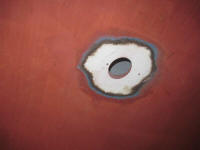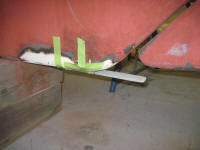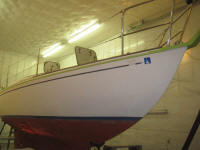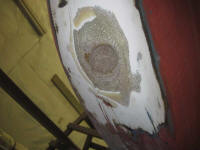
110 Cookson Lane | Whitefield, ME 04353 | 207-232-7600 | tim@lackeysailing.com
A small area on the leading edge of the keel required grinding and repair. A gouge here, the result of undesirable contact with the bottom edge of a body of water, had been temporarily filled with a flexible sealant, and there was moisture leaking from beneath the blob.
After setting myself up with tools, breathing apparatus, and everything else, I sanded away the bottom paint over an appropriately-large area, then ground into the damaged area, tapering and widening the gouge out to sound material in all directions. By the time I'd removed the damaged material, I'd exposed what appeared to be concrete within the ballast cavity.
It appeared the concrete contained moisture, and over the course of the day more seeped out, so I installed a heat lamp to hopefully hasten the expulsion of moisture to an extent that I could begin to patch and repair the area. For the moment, I left the scar open and addressed other things.
While I was sanding, I removed the paint from around the depthsounder transducer hole, so the new one would have clean gelcoat against which to bed. Similarly, I removed paint from the edges and underside of the aft end of the keel, so I could install a lobster buoy tab to span the gap between keel and rudder and eliminate this potential snag point.
I made the tab from 1/4" fiberglass, which I cut 1-1/2" wide and slightly shaped before gluing in place with epoxy. I left this to cure overnight before continuing with additional work.



To begin the preparations for hull preparation and painting, I solvent-washed the top part of the hull and aluminum rubrail to remove dirt and contaminants. Next, I moved the after jackstands forward a bit, then leveled the hull from side to side, measuring at both the bow and stern as needed. I'd need the hull level for striking a new waterline and boottop later in the process.
Then, I applied masking tape to the rubrail at the top of the hull, over the anchor roller as needed, and on the rudder pintles, gudgeons, and cheeks. I removed the backstay chainplates and tiller to make the job easier. Later, I'd sheathe the top of the boat in plastic to shield the decks and interior from sanding dust and, ultimately, paint spray. Cleaning and initial hull prep would be underway soon.


Total Time on This Job Today: 6 hours


